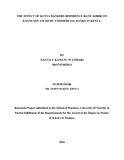| dc.contributor.author | Wathiari, Naftaly K | |
| dc.date.accessioned | 2017-01-13T12:38:41Z | |
| dc.date.available | 2017-01-13T12:38:41Z | |
| dc.date.issued | 2016 | |
| dc.identifier.uri | http://hdl.handle.net/11295/100393 | |
| dc.description.abstract | The Kenya Bankers Reference Rate (KBRR) was introduced in July 2014 as a common base lending rate for all commercial banks in Kenya through the concerted effort of the government, central bank and other stakeholders. Its main aim was to enhance transparency with cost of cost of products and competition among commercial banks which would result to a reduction in the lending rates to single digits. The reduction was to spike the supply of credit facilities/advances to the private sector leading to growth in the economy. This study therefore sought to determine the effects of the Kenya Bankers Reference Rate on the loans advanced by the commercial Banks in Kenya.
The study adopted a causal research design which was conducted so as to identify the extent and nature of cause-and-effect relationships among the variable. Monthly data on 43 commercial banks in operation between the periods 2013-2015 was analysed this being the entire population in the banking industry sourced from the Central Bank’s supervisory reports, banks financial statements and from the Kenya Bankers Association. An analysis was done using the STATA software and in addition a regression model was run through the OLS method. The study carried out inferential statistics tests to determine how introduction of KBRR has impacted total loans and advances by commercial banks in Kenya
The study concluded that KBRR positively influenced lending by commercial banks in Kenya. This is from the increased competition angle given that upon its introduction, all the commercial banks were subjected to the same base rate. However, testing for the level of significance of this effect, we found out that the effect is not statistically significant. This therefore calls for the review of the KBRR to find out why the effect could not be significant. This could be perhaps from the fact that KBRR could not still have addressed fully the information asymmetry problem within the Kenyan credit market. The researcher therefore recommends that the concerned stakeholders starting with the Central Bank of Kenya as the regulator to relook at KBRR mainly from the computational point of view. | en_US |
| dc.language.iso | en | en_US |
| dc.publisher | University Of Nairobi | en_US |
| dc.rights | Attribution-NonCommercial-NoDerivs 3.0 United States | * |
| dc.rights.uri | http://creativecommons.org/licenses/by-nc-nd/3.0/us/ | * |
| dc.subject | Commercial Banks In Kenya | en_US |
| dc.title | The Effect of Kenya Bankers Reference Rate (Kbrr) on Loans Advanced by Commercial Banks in Kenya | en_US |
| dc.type | Thesis | en_US |



